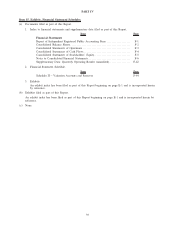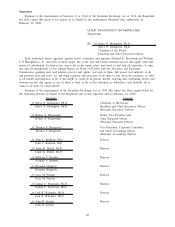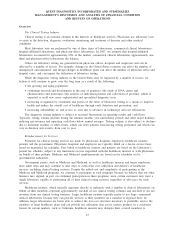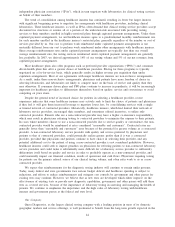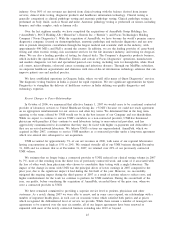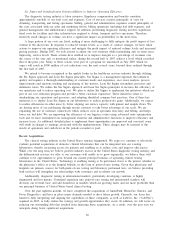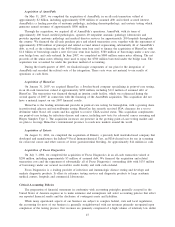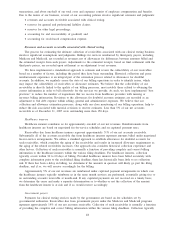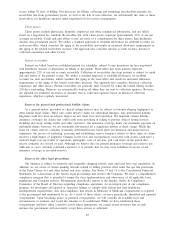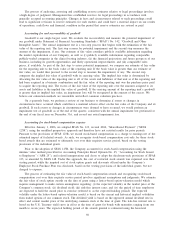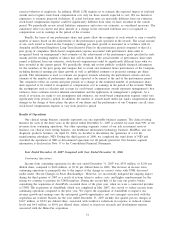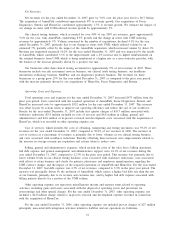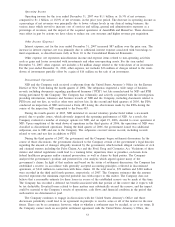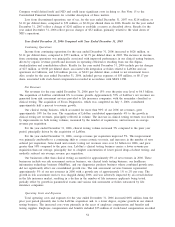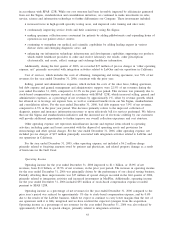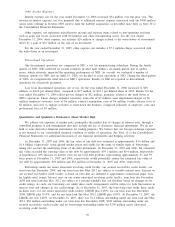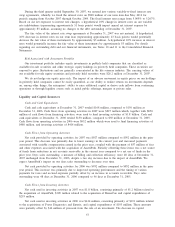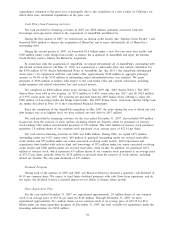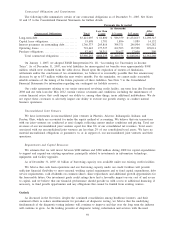Quest Diagnostics 2007 Annual Report Download - page 58
Download and view the complete annual report
Please find page 58 of the 2007 Quest Diagnostics annual report below. You can navigate through the pages in the report by either clicking on the pages listed below, or by using the keyword search tool below to find specific information within the annual report.occurs within 30 days of billing. Our processes for billing, collecting and estimating uncollectible amounts for
receivables due from government payers, as well as the risk of non-collection, are substantially the same as those
noted above for healthcare insurers under negotiated fee-for-service arrangements.
Client payers
Client payers include physicians, hospitals, employers and other commercial laboratories, and are billed
based on a negotiated fee schedule. Receivables due from client payers represent approximately 33% of our net
accounts receivable. Credit risk and ability to pay are more of a consideration for these payers than healthcare
insurers and government payers. We utilize a standard approach to establish allowances for doubtful accounts for
such receivables, which considers the aging of the receivables and results in increased allowance requirements as
the aging of the related receivables increase. Our approach also considers specific account reviews, historical
collection experience and other factors.
Patient receivables
Patients are billed based on established patient fee schedules, subject to any limitations on fees negotiated
with healthcare insurers or physicians on behalf of the patient. Receivables due from patients represent
approximately 22% of our net accounts receivable. Collection of receivables due from patients is subject to credit
risk and ability of the patients to pay. We utilize a standard approach to establish allowances for doubtful
accounts for such receivables, which considers the aging of the receivables and results in increased allowance
requirements as the aging of the related receivables increases. Our approach also considers historical collection
experience and other factors. Patient receivables are generally fully reserved for when the related billing reaches
210 days outstanding. Balances are automatically written off when they are sent to collection agencies. Reserves
are adjusted for estimated recoveries of amounts sent to collection agencies based on historical collection
experience, which is regularly monitored.
Reserves for general and professional liability claims
As a general matter, providers of clinical testing services may be subject to lawsuits alleging negligence or
other similar legal claims. These suits could involve claims for substantial damages. Any professional liability
litigation could also have an adverse impact on our client base and reputation. We maintain various liability
insurance coverages for claims that could result from providing or failing to provide clinical testing services
including inaccurate testing results and other exposures. Our insurance coverage limits our maximum exposure on
individual claims; however, we are essentially self-insured for a significant portion of these claims. While the
basis for claims reserves considers actuarially determined losses based upon our historical and projected loss
experience, the process of analyzing, assessing and establishing reserve estimates relative to these types of claims
involves a high degree of judgment. Changes in the facts and circumstances associated with claims could have a
material impact on our results of operations, principally costs of services, and cash flows in the period that
reserve estimates are revised or paid. Although we believe that our present insurance coverage and reserves are
sufficient to cover currently estimated exposures, it is possible that we may incur liabilities in excess of our
insurance coverage or recorded reserves.
Reserves for other legal proceedings
Our business is subject to extensive and frequently changing federal, state and local laws and regulations. In
addition, we are aware of certain pending lawsuits related to billing practices filed under the qui tam provisions
of the False Claims Act and other federal and state statutes. See Notes 15 and 16 to the Consolidated Financial
Statements for a discussion of the various legal proceedings that involve the Company. We have a comprehensive
compliance program that is intended to ensure the strict implementation and observance of all applicable laws,
regulations and Company policies. Management periodically reports to the Quality, Safety & Compliance
Committee of the Board of Directors regarding compliance operations. As an integral part of our compliance
program, we investigate all reported or suspected failures to comply with federal and state healthcare
reimbursement requirements. Any non-compliance that results in Medicare or Medicaid overpayments is reported
to the government and reimbursed by us. As a result of these efforts, we have periodically identified and reported
overpayments. Upon becoming aware of potential overpayments, we will consider all available facts and
circumstances to estimate and record the amounts to be reimbursed. While we have reimbursed these
overpayments and have taken corrective action where appropriate, we cannot assure investors that in each
instance the government will necessarily accept these actions as sufficient.
49


